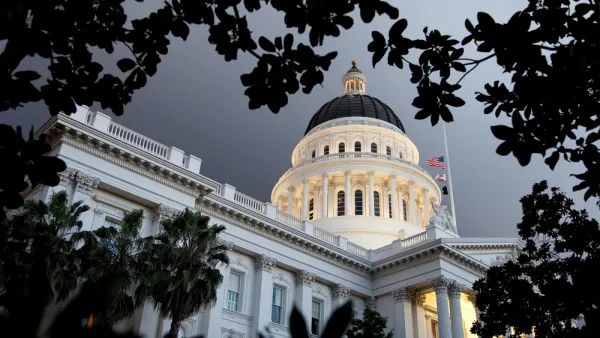Heretofore, California's transportation funding woes have largely been restricted to future projects, expressed as "deferred road and bridge maintenance." That just changed—now current budgets face a $754 million cut over five years.
"Faced with plummeting gasoline tax revenue, state transportation officials have announced plans to cut funding for road and transit projects by $754 million over the next five years, the greatest reduction in two decades," writes Patrick McGreevy for the Los Angeles Times. That amounts to a 38 percent decrease in funding, according to McGreevy.
The California Transportation Commission's press release of Jan. 22 indicates that the unprecedented move, in terms of size of the reduction, "was undertaken after careful review of current and projected financial information from numerous sources."
Ironically, a post earlier this month was entitled, "Will 2016 Be the Year California Finally Raises its 22-Year-Old Gas Tax?" What is certain is that barring any action by the legislature, the tax will fall again, as it did last July.
"The panel had estimated its funding based on a 14.1-cent excise tax on gasoline, but in December, Caltrans revealed a revised expectation that the tax would drop to 10 cents because of falling fuel prices, said Susan Bransen, a commission spokeswoman," writes Andrew McGall for the San Jose Mercury News.
"Each penny reduction in the gas tax decreases funding for state transportation projects by some $140 million a year," writes McGreevy.
As prior posts describing the nature of the infamous and complex 2010 "gas tax swap" explain, the Board of Equalization is charged with adjusting the gasoline excise tax annually to keep it equal to the 2010 tax, which included the state sales tax before it was converted to an excise tax. When gas prices fall, that means the board must do a downwards adjustment, as it did last year.
McGall goes on to list Bay Area transit and road projects that will be affected, including "BART's second phase expansion in Santa Clara Valley beyond the Berryessa station." The extension received $150 million last month in the omnibus spending bill.
"For L.A. County, $191 million in road and rail projects potentially could be delayed or terminated - including $129.4 million allocated for the purchase of light rail vehicles" writes McGreevy.
The California Transportation Commission approved the reduced revenue estimate on Jan. 21, the same day that Gov. Jerry Brown's gave his State of the State address where he indicated that infrastructure deficit had swelled from $59 billion to $77 billion, and the need to raise transportation revenue.
Recent attempts to pass an increase in the gas tax, now 40.62 cents [PDF], fourth highest in the nation after Pennsylvania, Washington and Hawaii, in last year's legislative session and even in a special session called by Brown have been unsuccessful, lacking the requisite votes to pass with a two-thirds majority.
Perhaps Republicans, who have been steadfast in refusing to raise any taxes, may be more flexible if projects in their districts will be affected by the cuts approved the commission, which will likely be the case according to David Siders of The Sacramento Bee:
“What this means is that almost every county in California that relies on this source of funding for projects that improve traffic and air quality will have to cut or delay projects indefinitely,” the commission’s Lucy Dunn said in a prepared statement.
- Increase the motor vehicle fuel (gasoline) tax [by $0.225 per gallon], including an inflation adjustment as provided, an increase of $38 in the annual vehicle registration fee, and a new $165 annual vehicle registration fee applicable to zero-emission motor vehicles, as defined.
- The bill would deposit the revenues attributable to a $0.30 per gallon increase in the diesel fuel excise tax imposed by the bill into the Trade Corridors Improvement Fund.
FULL STORY: California's falling gas tax revenue leads to massive cut in transit project funding

National Parks Layoffs Will Cause Communities to Lose Billions
Thousands of essential park workers were laid off this week, just before the busy spring break season.

Retro-silient?: America’s First “Eco-burb,” The Woodlands Turns 50
A master-planned community north of Houston offers lessons on green infrastructure and resilient design, but falls short of its founder’s lofty affordability and walkability goals.

Delivering for America Plan Will Downgrade Mail Service in at Least 49.5 Percent of Zip Codes
Republican and Democrat lawmakers criticize the plan for its disproportionate negative impact on rural communities.

Test News Post 1
This is a summary

Test News Headline 46
Test for the image on the front page.

Balancing Bombs and Butterflies: How the National Guard Protects a Rare Species
The National Guard at Fort Indiantown Gap uses GIS technology and land management strategies to balance military training with conservation efforts, ensuring the survival of the rare eastern regal fritillary butterfly.
Urban Design for Planners 1: Software Tools
This six-course series explores essential urban design concepts using open source software and equips planners with the tools they need to participate fully in the urban design process.
Planning for Universal Design
Learn the tools for implementing Universal Design in planning regulations.
EMC Planning Group, Inc.
Planetizen
Planetizen
Mpact (formerly Rail~Volution)
Great Falls Development Authority, Inc.
HUDs Office of Policy Development and Research
NYU Wagner Graduate School of Public Service



























